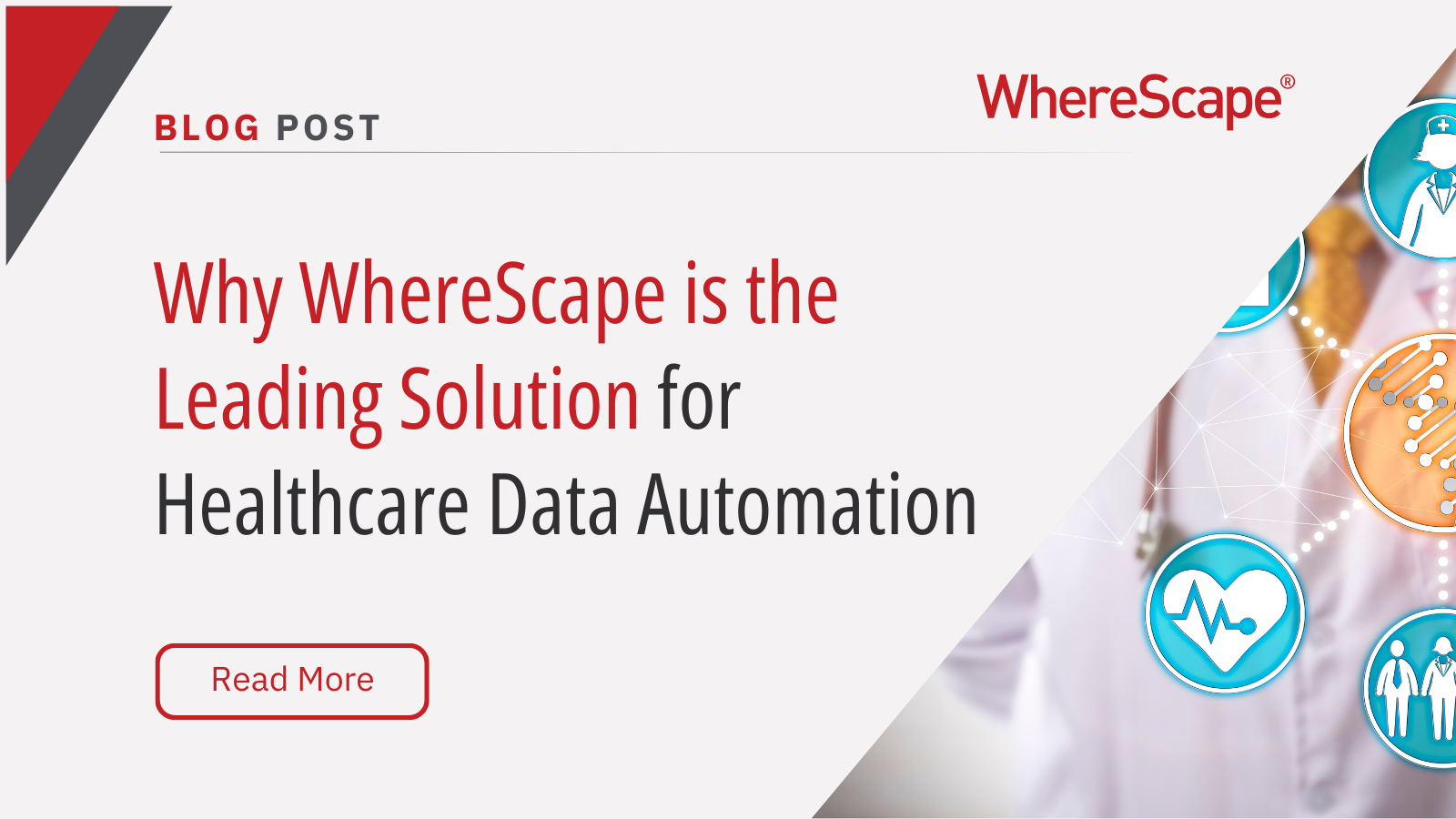Join WhereScape at the EDUCAUSE Annual...
Data Warehousing Best Practices
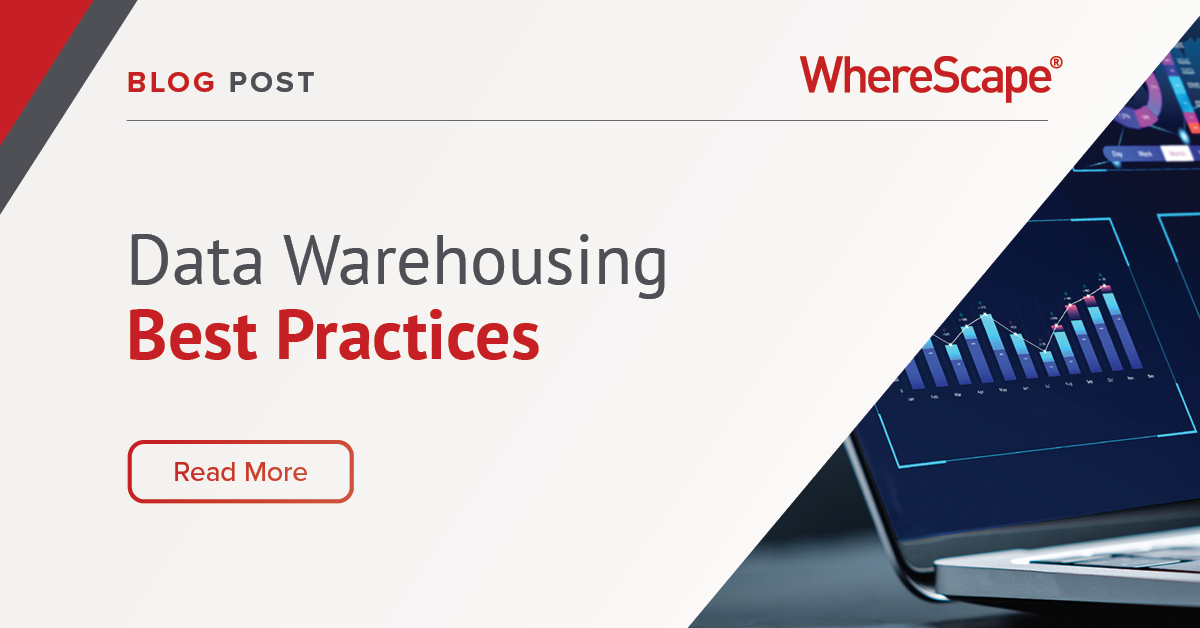
In modern times, organizations are daily generating huge volumes of data. Appreciating the significance of data, companies are storing data from different departments which can be analyzed to gather insights to help the organization in better decision-making. This data can run up to petabytes (1,000,000 gigabytes) on account of being collected from multiple sources and is generally stored in an unstructured format. Sometimes, organizations also rely on external data in addition to internal data in order to learn more about their market competition. A data warehouse allows for the aggregation of data from heterogeneous sources and storage in a single repository for the purpose of analysis, reporting, and business intelligence rather than transaction processing. It is the unification of components and technologies that helps in creating a strategic use of data.
The humongous amount of data stored in a data warehouse is derived from various applications such as marketing, sales, finance, customer-facing apps, external partner systems, etc. This is then run through transform and load processes to match the already-available data in the data warehouse. This data is then made accessible to decision-makers.
What is Data Warehousing?
Data warehousing is the process of systemizing data from multiple sources in an organization and storing it in a single place for further analysis, reporting, and business decision-making. Generally, organizations have a transactional database that contains information on all daily activities. Organizations also have other data sources – third-party or internal operations related. Data from all these sources are aggregated and stored in a data warehouse through an ELT or ETL process. The data model of this warehouse is designed in such a way that it is feasible to accumulate data from all these sources and make business decisions accordingly.
What is a Data Warehouse?
A data warehouse is designed to be a central storehouse for consolidating business or enterprise data from multiple sources. The data that flows within comes in all sorts and sizes – structured, semi-structured, and unstructured data. Furthermore, these data may come from various sources such as internal applications, customer-facing applications, and external systems.
Once the data enters the data warehouse, it is pushed further for load, transformation and processing and other predefined steps to transform it into information that it may be accessed quickly and utilized for decision-making. Consolidation of large quantities of information in the data warehouse can help an organization in forming a more holistic analysis to ensure that it has already considered all available information before arriving at a decision.
What Does Data Warehousing Allow Organizations to Achieve?
Organizations usually fail to implement a Data Warehouse simply because they have not been able to establish a clear business use case for it. Organizations that take it up by recognizing a business problem for their data, can stay focused on finding a solution.
Here are a few primary reasons why having a Data Warehouse is advantageous:
- Improved Decision-Making: Data Warehousing enhances the efficiency and speed of data access, enabling business leaders to make data-driven strategies and outperform the competition.
- Standardization of Data: Data Warehouses store data in a standard format making it easier for business leaders to analyze it and extract applicable insights from it. Standardization of data collected from various heterogeneous sources brings down the risk of errors and boosts overall accuracy.
- Reduction of Costs: Data Warehouses allow decision-makers to dive deeper into historical data and ensure the success of past initiatives. They can also visualize course correction to minimize costs, drive growth, and raise operational efficiencies.
Data warehouses serve as flexible and scalable data storehouses for centralizing an enterprise’s data and facilitating the examination of information for analytics. Businesses continue to embrace data warehouses at a rapid pace.
Data Warehouse Best Practices
Compiled below is a list of six data warehouse best practices that can assist businesses to serve their requirements and improve time to value for data analytics and business intelligence.
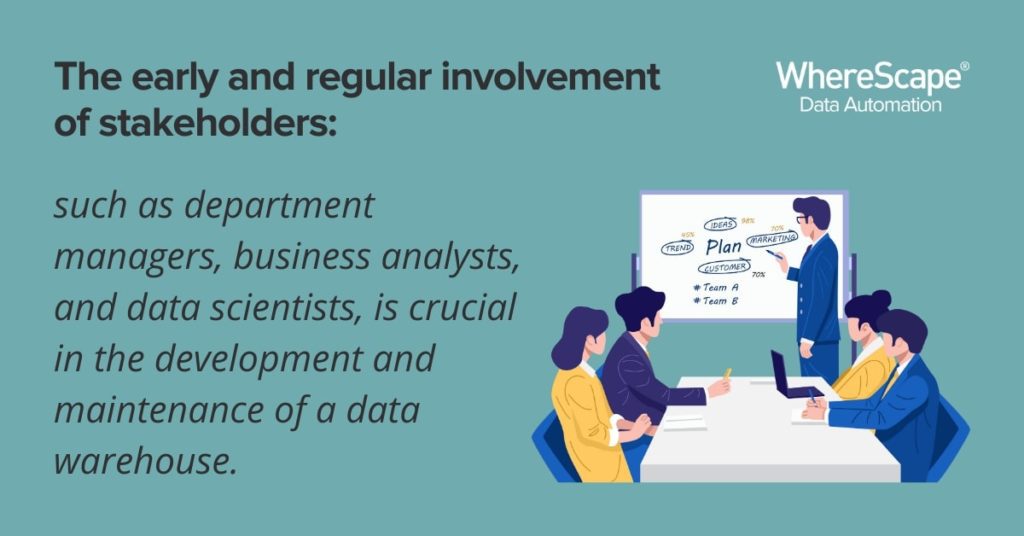
- Early and regular involvement of stakeholders early and often
A data warehouse must meet the requirements of various stakeholders like department managers, business analysts, and data scientists, as they all need to access the information contained in the warehouse to run analyses and generate reports. Incorporating feedback from these parties improves the chances of an organization’s decision-makers having the information necessary at their disposal to make informed choices and reduce the chances of having to carry out a major overhaul later. Without the support of management, a data warehouse project may never get off the ground, or may even be abandoned mid-way.
- Incorporation of data governance
If poor-quality data is fed into a warehouse, then centralizing it for analytics is fruitless — the results of analyses will be inaccurate and misleading – garbage in, garbage out. To keep away from this, organizations must implement a robust data governance process where all departments must collectively work to define the security, collaboration, and retention policies for their data assets based on business and legal requirements.
- Defining user roles
Defining user roles to determine who can read, write, and update data within a warehouse is of paramount importance. Without appropriate processes and access control in place, users will bring down the data pipeline over a period of time by failing to coordinate their efforts, especially at large organizations where many analysts are working with the data warehouse. Nonetheless, enterprises must also ensure that their user controls are not very restrictive, as excessively bureaucratic systems inhibit productivity by blocking experimentation and iteration.
Organizations must find the right balance between security and the operational flexibility imperative for analysts to work effectively. As part of this balance, an enterprise might have analysts set up sandboxes for testing changes to data structures and requiring that prior approval be obtained before merging altered data.
- Understanding schema design of data warehouse
An organization must design its schemas to fit the business needs with the data warehouse technology being implemented. Nowadays, the scalability of cloud data warehouses allows for the denormalization of data to increase querying speed free of resource constraints.
- Frequent iteration and testing
Adopting an agile approach toward the development and maintenance of a data warehouse can improve the repository’s performance and ability to adjust to an organization’s ever-changing requirements. Implementation of short development cycles with small, well-defined tasks and testing plans, helps the development teams to get faster feedback from relevant stakeholders and then continuously iterate to upgrade their systems and processes. This establishes a quick feedback loop for product development and allows for the identification and resolution of issues with the warehouse before any impact on user service.
- Effective exploitation of ELT and cloud data warehouses
ETL (extract, transform, load) and ELT (extract, load, transform) are two processes used for ingesting data from its source, transforming it as needed, and storing it in the data warehouse. By shifting the transformation step to the end of the process, ELT allows for ingesting data and quick commencement of data analysis. Cloud data warehouses are convenient for usage with ELT, as their scalable CPU resources can handle data transformation after loading. Cloud data warehouses have several other advantages as compared to their on-premises counterparts.
Since ELT loads data into the target system before it’s transformed, an enterprise must have a data modeling tool to prepare data for use in analytics. The data engineers who design and maintain data warehouses must seek guidance from subject matter experts in order to provide end users with data in a format that suits their requirements.
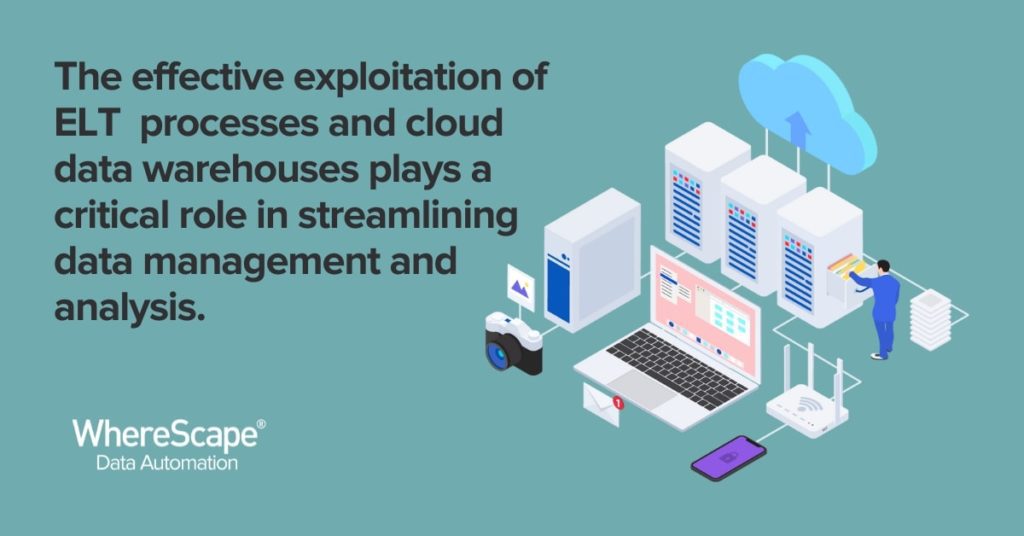
Implementing a Data Warehouse
Other than the major practices listed above, there are several other factors that determine the success of a data warehouse implementation. Some of the critical ones are as follows.
- Metadata management – Documentation of metadata related to all the source tables, staging tables, and derived tables is extremely critical in extracting actionable insights from the data. It is feasible to design the ELT tool in order to capture even the data lineage. Some of the widely popular ELT tools also perform well in tracking data lineage.
- Logging – Logging is often an overlooked aspect. Having a centralized storehouse wherein logs can be inspected and analyzed goes a long way in quick debugging and the creation of a robust ELT process.
- Data concatenation – Most ELT tools have the ability to concatenate data in the extraction and transformation phases. It is advantageous to examine whether expensive joins are required in the ELT tool or whether the database handles that. In most cases, databases are better optimized for handling joins.
- Compartmentalization of transaction databases – Transaction databases are required to be kept separate from extract jobs and it is always best to execute these on a staging or a replica table such that the performance of the primary operational database remains glitch-free.
- Status monitoring and alerts – Continuous monitoring of the ETL/ELT process and incorporating the provision for alerts is important in ensuring system reliability.
- Point of time recovery – Even with the best of monitoring, logging, and fault tolerance, these complex systems may run into faults. Having the ability to recover from such faults in previous states must also be considered during the data warehouse process design.
To summarize
The success of a project such as the implementation of a data warehouse development is highly dependent on an understanding of the business, its IT needs, and its pain points. Comprehension of all these aspects helps the business give the structure it needs to be successful in data warehousing efforts. Before getting into data warehouse development, it is advisable to revisit the above-listed data warehouse best practices in order to save time in project development and achieve maximum cost optimization.
If you want to have a one-on-one discussion with our Solutions Architects at WhereScape about best practices, or if you have any questions about automating the ELT pipeline, contact us here!
Automating Data Vault in Databricks | WhereScape Recap
Automating Data Vault in Databricks can reduce time-to-value by up to 70%—and that’s why we hosted a recent WhereScape webinar to show exactly how. At WhereScape, modern data teams shouldn't have to choose between agility and governance. That's why we hosted a live...
WhereScape Recap: Highlights From Big Data & AI World London 2025
Big Data & AI World London 2025 brought together thousands of data and AI professionals at ExCeL London—and WhereScape was right in the middle of the action. With automation taking center stage across the industry, it was no surprise that our booth and sessions...
Why WhereScape is the Leading Solution for Healthcare Data Automation
Optimizing Healthcare Data Management with Automation Healthcare organizations manage vast amounts of medical data across EHR systems, billing platforms, clinical research, and operational analytics. However, healthcare data integration remains a challenge due to...
WhereScape Q&A: Your Top Questions Answered on Data Vault and Databricks
During our latest WhereScape webinar, attendees had fantastic questions about Data Vault 2.0, Databricks, and metadata automation. We’ve compiled the best questions and answers to help you understand how WhereScape streamlines data modeling, automation, and...
What is Data Fabric? A Smarter Way for Data Management
As of 2023, the global data fabric market was valued at $2.29 billion and is projected to grow to $12.91 billion by 2032, reflecting the critical role and rapid adoption of data fabric solutions in modern data management. The integration of data fabric solutions...
Want Better AI Data Management? Data Automation is the Answer
Understanding the AI Landscape Imagine losing 6% of your annual revenue—simply due to poor data quality. A recent survey found that underperforming AI models, built using low-quality or inaccurate data, cost companies an average of $406 million annually. Artificial...
RED 10: The ‘Git Friendly’ Revolution for CI/CD in Data Warehousing
For years, WhereScape RED has been the engine that powers rapidly built and high performance data warehouses. And while RED 10 has quietly empowered organizations since its launch in 2023, our latest 10.4 release is a game changer. We have dubbed this landmark update...
The Assembly Line for Your Data: How Automation Transforms Data Projects
Imagine an old-fashioned assembly line. Workers pass components down the line, each adding their own piece. It’s repetitive, prone to errors, and can grind to a halt if one person falls behind. Now, picture the modern version—robots assembling products with speed,...
The Role of Clean Data in AI Success: Avoiding “Garbage In, Garbage Out”
Co-authored by infoVia and WhereScape Artificial Intelligence (AI) is transforming industries across the globe, enabling organizations to uncover insights, automate processes, and make smarter decisions. However, one universal truth remains: the effectiveness of any...
What is a Cloud Data Warehouse?
As organizations increasingly turn to data-driven decision-making, the demand for cloud data warehouses continues to rise. The cloud data warehouse market is projected to grow significantly, reaching $10.42 billion by 2026 with a compound annual growth rate (CAGR) of...
Related Content

Automating Data Vault in Databricks | WhereScape Recap
Automating Data Vault in Databricks can reduce time-to-value by up to 70%—and that’s why we hosted a recent WhereScape webinar to show exactly how. At WhereScape, modern data teams shouldn't have to choose between agility and governance. That's why we hosted a live...

WhereScape Recap: Highlights From Big Data & AI World London 2025
Big Data & AI World London 2025 brought together thousands of data and AI professionals at ExCeL London—and WhereScape was right in the middle of the action. With automation taking center stage across the industry, it was no surprise that our booth and sessions...
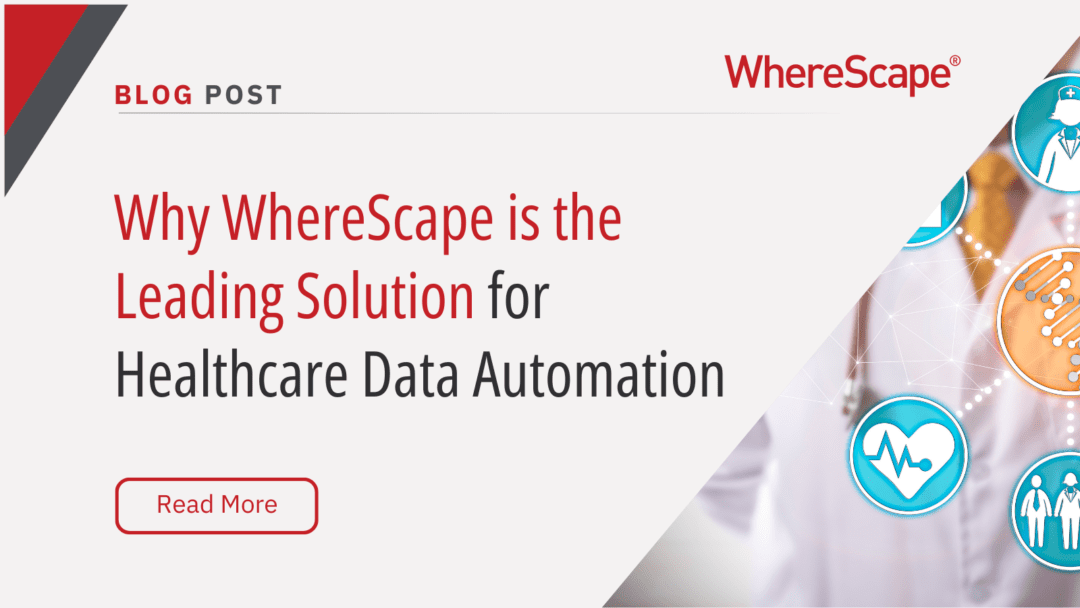
Why WhereScape is the Leading Solution for Healthcare Data Automation
Optimizing Healthcare Data Management with Automation Healthcare organizations manage vast amounts of medical data across EHR systems, billing platforms, clinical research, and operational analytics. However, healthcare data integration remains a challenge due to...

WhereScape Q&A: Your Top Questions Answered on Data Vault and Databricks
During our latest WhereScape webinar, attendees had fantastic questions about Data Vault 2.0, Databricks, and metadata automation. We’ve compiled the best questions and answers to help you understand how WhereScape streamlines data modeling, automation, and...




